In 2000 the 40c (plus 5c donation) and 80c (plus 5c donation) Health stamps were part of a wider stamp issue called Children's Health - Bears and Dolls. The 5c surcharge raised from the sale of the 40c and 80c stamps was donated to the seven New Zealand Children’s Health Camps. This issue included pre-loved and modern day bears and dolls, including a selection made by well-known New Zealand artists.
Issue information
The name teddy bear is thought to have originated from a cartoon by Clifford Berryman entitled Drawing the Line in Mississippi that appeared in the Washington Post in November 1902. It depicted the American President Theodore ‘Teddy’ Roosevelt, refusing to shoot a captive bear cub during a bear hunt in Mississippi. Inspired by the cartoon, Morris Michtom displayed a soft brown plush toy bear in his shop window labelled 'Teddy’s Bear’. It was a success. Over the years, the teddy has evolved and progressed from a child’s toy to the present day collector’s item. The oldest teddy bear in New Zealand is believed to have been brought here by a sailor for his niece, an American bear made by Rose Michtom in 1920.
Dolls are thought to have originated from the 17th century French ‘fashion’ dolls, made to transport miniature copies of the latest French fashions to the courts of Europe. The earliest fashion dolls were simple carved wooden figures, but during the last half of the 19th century they became more sophisticated, with beautiful porcelain faces and jointed bodies of wood and leather. New Zealand’s earliest doll is rumoured to be a simple wooden doll from the Queen Anne period.
The antique French doll and wooden Schoenhut doll that featured on the 85c stamp, and the Chad Valley bear on the $1.10 stamp, were very popular in New Zealand before World War II because New Zealand was not making bears and dolls at the time. The female French doll is thought to have been made by Jumeau in the 1890's, world renowned for its quality production and elegance. The male doll, the All Wood Perfection Art Doll, was patented by Albert Schoenhut on 17 January 1911. It is jointed with metal springs, and holds any 'human' position in which it is placed.
The $1.20 stamp featured Poppy, made by Debbie Pointon. Debbie won Doll of the Year at the Wellington Doll and Bear Festival from 1996 to 1998. The $1.80 stamp included Lia, a cloth doll made by Gloria Young in 1991, also recognised for her original doll-making work.
Geronimo, made by Rose Hill in 1996, is made of white mohair and featured on both of the 45c stamps (gummed and self-adhesive). Mohair is a natural straight fibre that is hard wearing, takes dye easily, looks realistic, and is still used for making teddy bears. The $1.50 stamp featured two more bears - Swanni (large bear) by Robin Rive, and Dear John (small bear) also made by Rose Hill. The $1.80 stamp featured another small bear, one of two identical bears bought in Scotland before World War II and posted to identical twin granddaughters in Christchurch.
The gummed stamps of this issue were produced as single stamps and as a block of six stamps.
Acknowledgements
A big thank you goes to the following people for their contributions to this stamp issue:
- Rose Hill of Auckland for her 1996 Geronimo bear that featured on the 40c + 5c stamps, and 1996 Dear John bear on the $1.50 stamp,
- Debbie Pointon of Paraparaumu for her porcelain doll named Poppy on the $1.20 stamp,
- Jan McLean from Dunedin for her doll name Polly depicted on the miniature sheet,
- Syndi Muif of Muir Bears in Akaroa for the miniature bears used on the first day cover design,
- Te Papa Tongarewa for the loan of the wooden toy box (made by Leon and Victor deVillalier).
Product Listing for 2000 Children's Health - Bears and Dolls
| Image | Title | Description | Price |
|---|---|---|---|
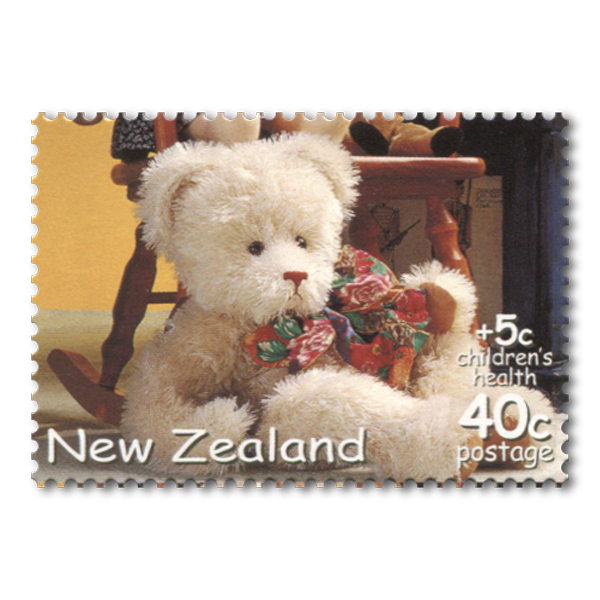 |
Single Stamp |
Single 40c + 5c 'White Mohair Bear' gummed stamp. Rose Hill’s Geronimo spent much of his life in a suitcase. He has attended bear making classes and doll and bear shows all around New Zealand. The white mohair of Geronimo’s coat is still in its ‘raw’ state. All woven mohair fur fabrics start at this ‘string’ stage, before they are dyed. Today’s bear makers have a wide variety of fur fabrics to choose from, including the traditional mohair. The colour range, and fur textures, available today from textile houses in both England and Germany, has meant that bear makers can create ‘characters’ never imagined by the first bear makers. |
$0.45 |
 |
Single Stamp |
Single 80c + 5c 'French Porcelain and American Wood Dolls' gummed stamp. This small unmarked French Girl, with her porcelain head and fully jointed body, has been attributed to Jumeau. In the 1880's and 1890's the name Jumeau would have been widely recognised in the doll world. Regarded as the epitome of Porcelain dolls, examples in good condition are prized by collectors throughout the world. French dolls are not common in New Zealand. Immigrants in the 19th century were seldom wealthy enough to provide such toys, and there are many stories of favourite dolls being left behind, because it was feared they would not survive the voyage. The unusual boy doll, carved out of solid wood was made by the American manufacturer Schoenhut, who invented a unique jointing system of metal springs. Schoenhut patented this jointing method in 1911 and subsequent dolls were often labelled with this date. This example has been fortunate to retain his face paint. Wooden dolls often have their features repainted when the surface is chipped, but the original coating is more valued by collectors. |
$0.85 |
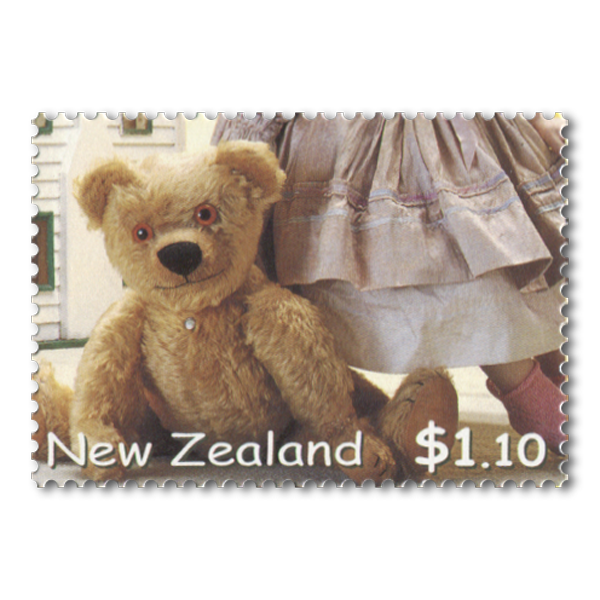 |
Single Stamp |
Single $1.10 'Chad Valley Bear' gummed stamp. The name ‘Chad’ comes from the stream that ran beside the factory where this bear was made. Made in the 1920s, his plush pile mohair fur and large nose are typical of this family of bears. After World War I England banned German imports and English factories, like Merrythought, Farnell and Chad Valley, grew quickly to fill much of the German export market. The Chad Valley company had started as a book bindery, but by the beginning of World War I they were making an increasing range of simple toys. Their first bears were produced in 1915 and by the mid 1920s they were known for their high quality bears and cloth dolls. They patented their own stuffing machine to fill toys with such diverse materials as Kapok and cork chips. |
$1.10 |
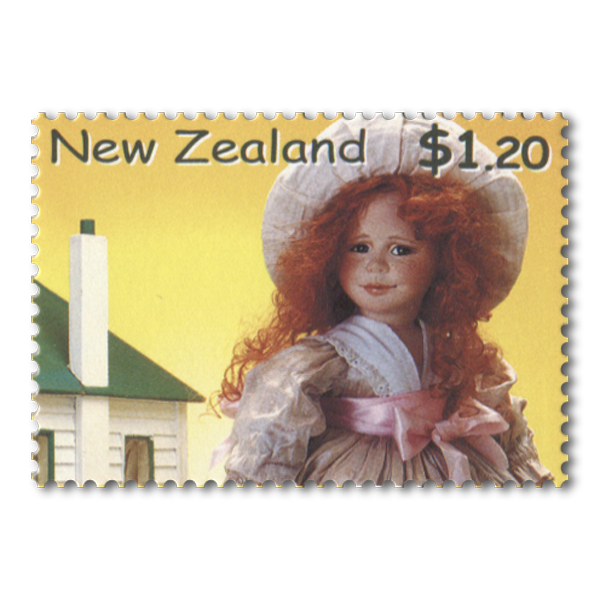 |
Single Stamp |
Single $1.20 'Porcelain Doll' gummed stamp. Award winning doll artist Debbie Pointon’s Poppy is a blend of two era’s. Sculpted as a likeness to her present child-owner, Debbie also wanted to portray the image of a child of early European settlers. Debbie has worked in many different artistic fields. She started doll making in 1990, bringing her watercolour painting skills to the delicate reproduction of antique dolls. Often inspired by the world of fairy and fantasy her ‘one of a kind’ creations are eagerly awaited by collectors of both Art and Dolls. International recognition for her work has seen Debbie fly to Australia as a special guest at an International Doll Symposium. Her work is regularly exhibited at shows and galleries around the country. |
$1.20 |
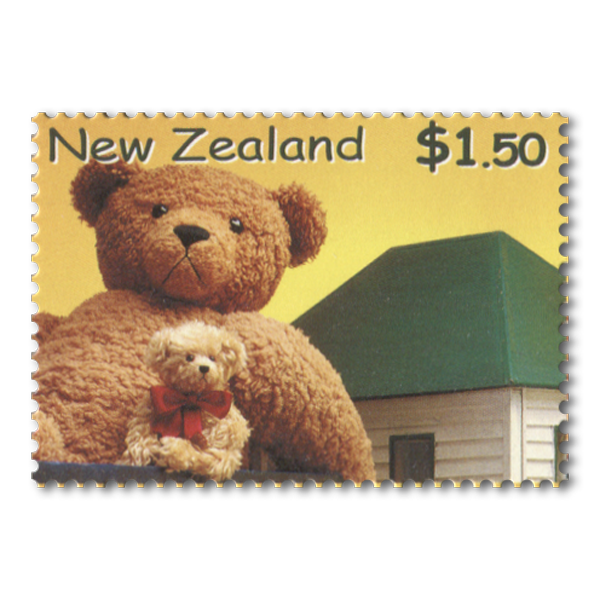 |
Single Stamp |
Single $1.50 'Large and Small Bear' gummed stamp. These two bears have very different backgrounds. Dear John is the name of the small mohair bear made by Rose Hill in 1996. He is one of a range of pattern designs developed for people who make their own bears. His slightly curly mohair gives him a rather scruffy appeal. Plastic pellets weight his arms and legs so he will always sit in a relaxed pose. Named Swannee, the larger bear belongs to Robin Rive, and is typical of bears manufactured in New Zealand in the 1980's. This example is made of a synthetic fur and quite softly stuffed. New Zealand manufacturers of bears, and other soft toys, over the last 20 years, initially followed American design trends. However, as the bear collecting market grew, manufacturers brought out their own ranges using local talent. Limited editions of many designs, often made of mohair, became affordable gifts for children and collectors alike. |
$1.50 |
 |
Single Stamp |
Single $1.80 'Cloth Doll and Small Mohair Bear' gummed stamp. Gloria Young began her doll making in 1974, about the time her daughter, Lia, was born. This cloth doll, made in 1991 and dressed in a simple cotton print, is a portrait of Lia at about the age of three. She hugs a small, well-loved teddy bear. One of a pair, the bear was sent as a gift from a grandparent to identical twin girls in Christchurch, New Zealand. Originally purchased in Scotland, he was probably made in England in the 1930's. Children raised during the depression and World War II learned to look after the few toys available. At that time there was little in the way of commercial toy production in New Zealand. Imported toys were expensive, and most came from English manufacturers. Once outgrown, they were handed on to younger siblings or the next generation. |
$1.80 |
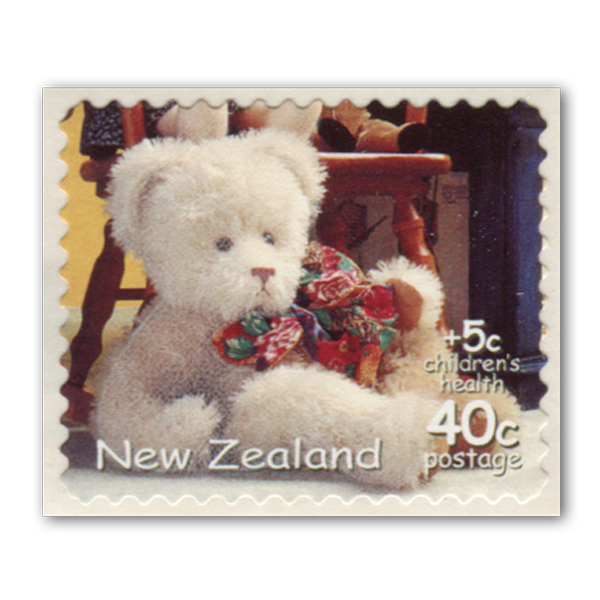 |
Single Stamp | Single 40c + 5c 'White Mohair Bear' self-adhesive stamp. | $0.45 |
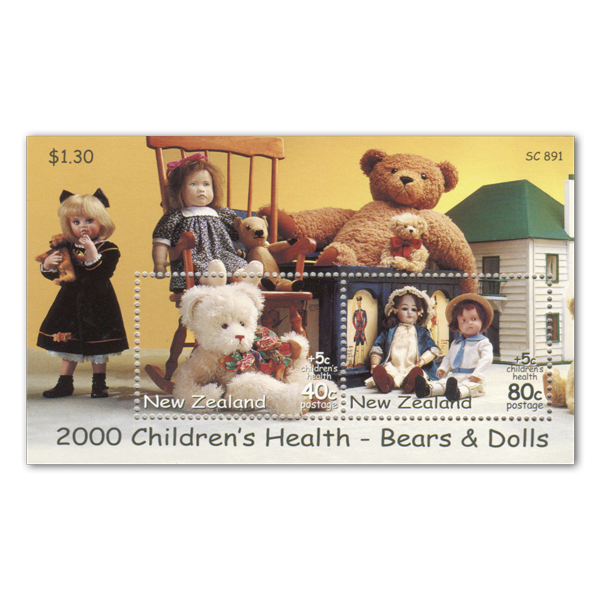 |
Miniature Sheet | Mint, used or cancelled miniature sheet. | $1.30 |
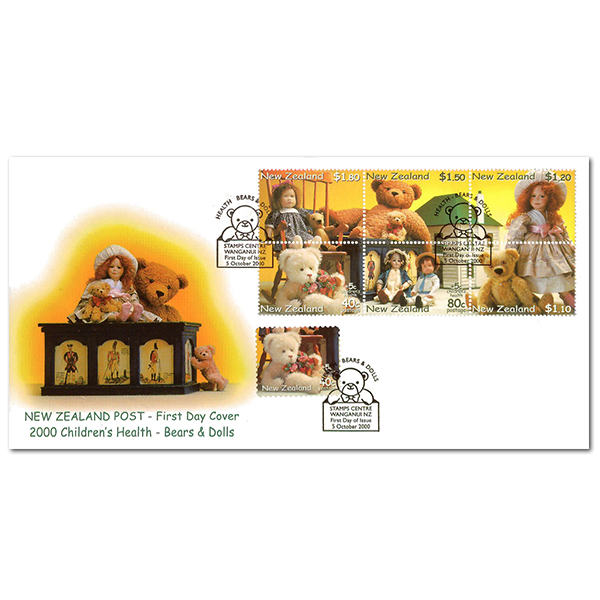 |
First Day Cover | First day cover with se-tenant block of six stamps and self-adhesive stamp affixed. Cancelled on the first day of issue. | $7.85 |
 |
Miniature Sheet First Day Cover | First day cover with miniature sheet affixed. Cancelled on the first day of issue. | $1.80 |
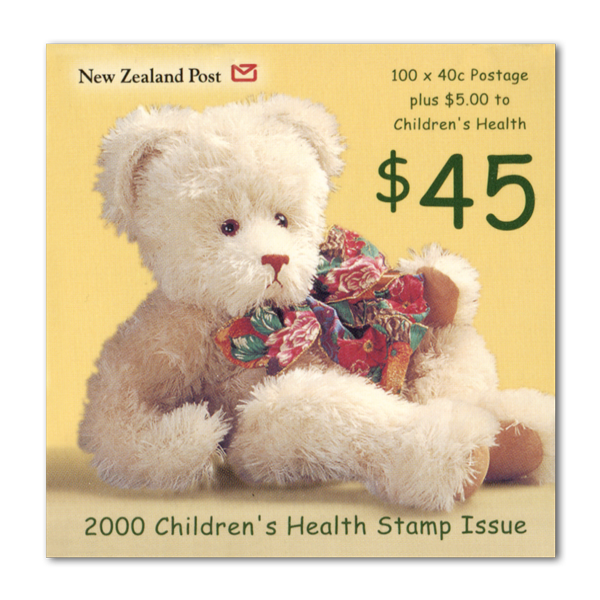 |
Self-adhesive Dispenser | Dispenser box containing 100 x 45c self-adhesive stamps. | $45.00 |
Technical information
| Date of issue: | 5 October 2000 |
|---|---|
| Number of stamps: | Seven |
| Denominations and designs: | Self-adhesive - 40c + 5c White Mohair Bear; Gummed - 40c + 5c White Mohair Bear, 80c + 5c French Porcelain and American Wood Dolls, $1.10 Chad Valley Bear, $1.20 Porcelain Doll, $1.50 Large and Small Bear, and $1.80 Cloth Doll and Small Mohair Bear |
| Stamps, miniature sheet, dispenser and first day covers designed by: | New Zealand Post Stamps Business, Wellington, New Zealand |
| Printer and process: | Gummed stamps: Southern Colour Print, New Zealand; Self-adhesive stamps: Australia Post Sprintpak, Australia |
| Number of colours: | Four process colours |
| Stamp size and format: | Gummed: 26mm x 37.5mm horizontal; Self-adhesive: 25mm x 30mm horizontal |
| Paper type: | Gummed: 103gsm De la Rue red phosphor coated; Self-adhesive: JAC phosphor tagged stock |
| Number of stamps per sheet: | 50 |
| Perforation gauge: | 14 and die cut |
| Special blocks: | Plate/imprint blocks could be obtained by purchasing at least six stamps from a sheet. Barcode or value blocks could be obtained by purchasing at least two stamps from a sheet. Barcode blocks were available in both A and B for stamp sheets. Special blocks were not available for self-adhesive stamps. |
| Period of sale: | These stamps remained on sale until 5 October 2001. |

